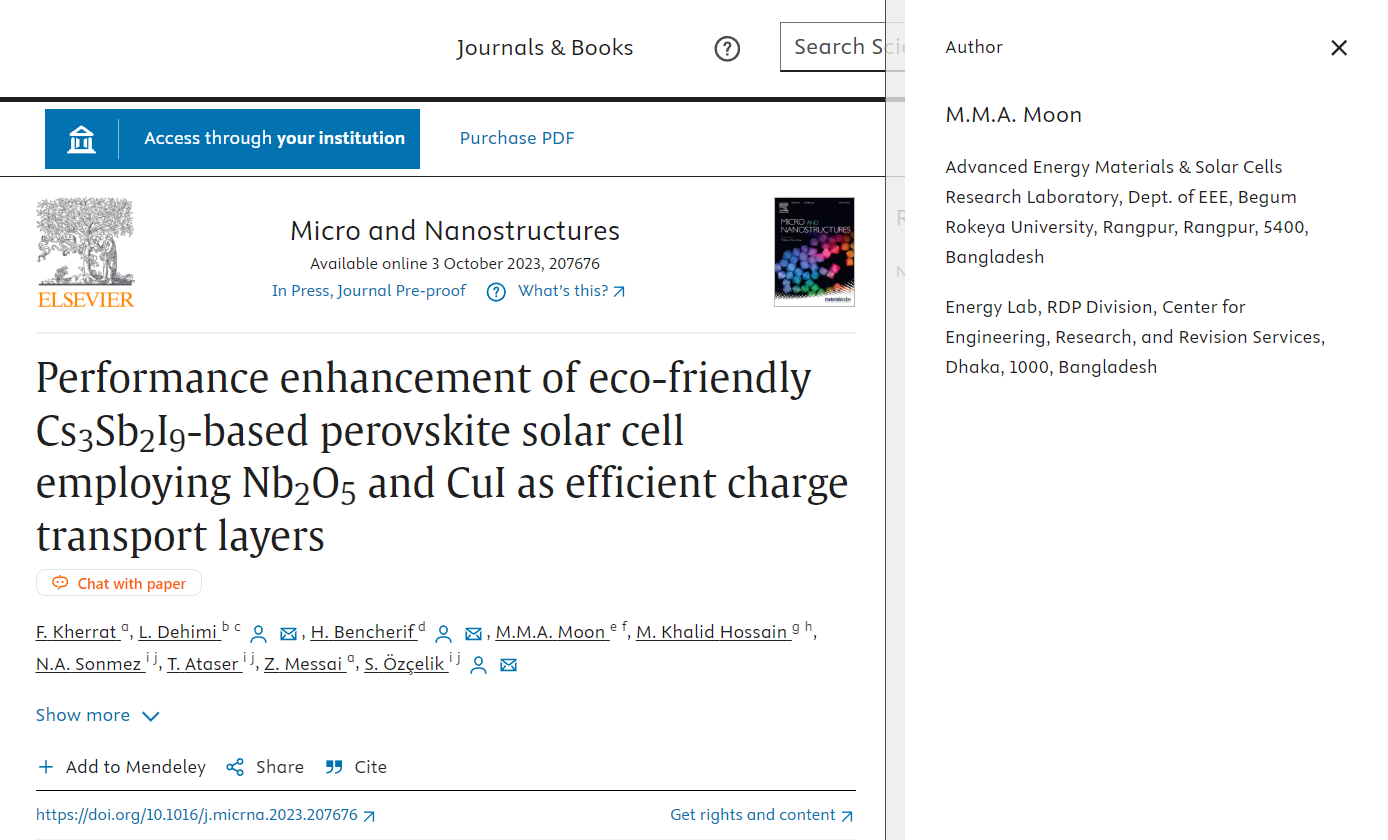Celebrating Success: Our Collaborative Research Shines in Elsevier's "Micro and Nanostructures" Journal
We are thrilled to announce the publication of our latest research collaboration. Our Managing Director and CEO, Md. Mahabub Alam Moon, hailing from the Energy Lab in the Research, Development, and Publication (RDP) Division at the Center for Engineering, Research, and Revision Services (CERRS), Dhaka 1000, Bangladesh, has partnered with Ms. Kherrat Fadila, a distinguished teacher-researcher from the Mohamed El Bachir El Ibrahimi University of Bordj Bou Arréridj, Algeria. This collaboration has yielded exceptional results, and we extend our cheers to all the authors involved in this remarkable endeavor!
Since January 2021, Mr. Moon has had the privilege of working as an Overseas Research Collaborator, providing unwavering support to Ms. Fadila on an exceptional project. Today, we celebrate the fruits of their labor! Their paper, titled "Performance Enhancement of Eco-friendly Cs3Sb2I9-based Perovskite Solar Cell Employing Nb2O5 and CuI as Efficient Charge Transport Layers," has just been published in the prestigious "Micro and Nanostructures" journal, formerly known as "Superlattices and Microstructures," published by Elsevier Ltd., UK. The journal boasts an impressive 2022 Impact Factor of 3.1 and a CiteScore of 6.1.
Paper URL: https://www.sciencedirect.com/science/article/abs/pii/S2773012323001735?via%3Dihub
About the Energy Lab at CERRS:
The Energy Lab at CERRS is at the forefront of cutting-edge research and development in sustainable energy solutions. Some key points that highlight the work of this remarkable lab include:
- Pioneering research in renewable energy sources, with a specific focus on solar cell technology.
- Developing innovative approaches to enhance the efficiency and performance of eco-friendly solar cells.
- Collaborating with international researchers to bridge gaps in knowledge and push the boundaries of scientific discovery.
- A dedication to fostering collaborations with outstanding international native researchers.
This achievement is a testament to the power of collaboration and the unwavering dedication of our team to push the boundaries of scientific knowledge. We are excited about the potential impact of this research on the field of solar energy and look forward to further breakthroughs in the future.
Article Highlights:
- An innovative approach for improving the Cs3Sb2I9/CTL interfaces by creating a spike-like conformation using Nb2O5 and CuI charge transport materials was proposed.
- The improved performance of the Cs3Sb2I9 solar cell is the result of a combination of high transport rates and minimal recombination at the proper energy levels.
- The addition of the CuI layer improves the functionality of the planar Cs3Sb2I9 device built on Nb2O5.
- Back contact properties are optimized to gain the best ohmic configuration to improve the collection mechanism.
- The obtained results will facilitate researchers in choosing the appropriate CTLs for solar cells, which will demonstrate increased tolerance against interface defects by achieving optimal interface band alignment.
Stay tuned for more exciting developments in the world of science and technology as we continue to explore new frontiers and make strides toward a sustainable and eco-friendly future. Thank you for your continued support!
📚🌏🔬
#EnergyLab #CERRS #Research #SolarCells
#Collaboration #Publications #AcademicExcellence
#MicroAndNanostructures #SuperlatticesAndMicrostructures #Elsevier
[7:14 PM, October 3, 2023; Dhaka, Bangladesh]

